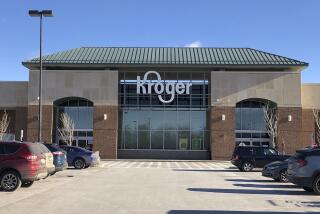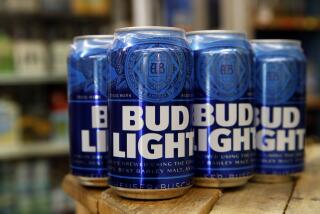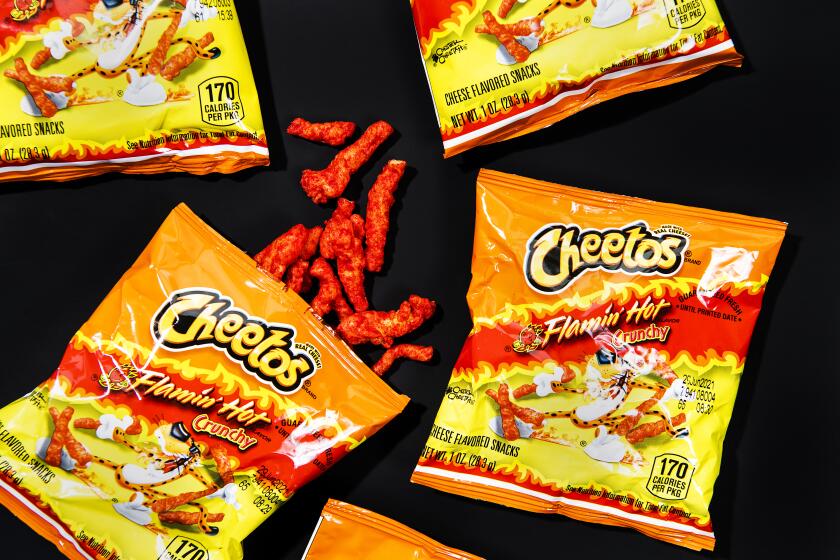MillerCoors CEO Tom Long seeks growth with craft beers
- Share via
Reporting from Chicago — Tom Long, MillerCoors’ new chief executive, wants to prove that big beer hasn’t gone flat.
But persistently high unemployment, an uncertain economy and young consumers’ shrinking thirst for mainstream beer are standing in his way.
A month since taking the reins of MillerCoors, Long is shifting the Chicago company from cost-cutting to growth mode.
SABMiller of London and Molson Coors Brewing Co. of Denver merged their U.S. operations in 2008 to better compete with Anheuser-Busch of St. Louis, the world’s largest brewer, which is owned by Belgium-based Anheuser-Busch InBev. Three years and $684 million in cost savings later, Long said, MillerCoors, the maker of Coors Light, Blue Moon and Leinenkugel, is poised to boost profits.
“It is clear we have done quite well in capturing synergies, which was the promise of the joint venture initially, and that was stage one,” Long, 52, said in his first interview since taking over as CEO at MillerCoors’ Milwaukee offices. “Organic growth in craft and imports and light beer is our ambition because our future earnings power will come from that growth more than from cost savings, and so that is the challenge of the business.”
Long, a North Carolina native with a master’s degree in business administration from Harvard, has the manner of a Southern gentleman with the cadence of a marketing veteran. He spent 17 years at Coca-Cola Co., eventually serving as president of the Atlanta company’s Northwest European division.
Long joined Miller Brewing Co. as chief marketing officer in 2005 and was promoted to CEO the next year. He took the position of chief commercial officer when the MillerCoors joint venture was formed in 2008, ceding the top job to veteran Leo Kiely. Last fall Kiely announced that Long would begin sharing CEO responsibilities with him, although no titles were changed at the time.
Long took over as CEO in June, and analysts expect the transition to be smooth.
“The fact that they’ve brought someone up from the inside suggests that presumably he buys into the brand, which suggests there will be some continuity in the brand focus,” Morningstar equities analyst Phil Gorham said.
Experts say Long will be judged by his ability to turn the company’s sales around.
“The savings angle has kind of run its course and the next chapter has to be about growth,” said Benj Steinman, president of Beer Marketer’s Insights. “They’ve got to deliver the goods in a tough market for mainstream domestic beers.”
Beer shipments declined 2% in 2009 and 1% in 2010, the first consecutive-year slide since the mid-1990s. U.S. shipments are expected to be flat or slightly down in 2011. Another down year would mark the first three-year slide since the 1940s.
MillerCoors and Anheuser-Busch have pointed to high unemployment among 21- to 34-year-old men, their best customers, as the primary reason for slipping sales.
Both companies lost U.S. market share last year, according to Beer Marketer’s Insights. Anheuser-Busch slipped a full percentage point, to 47.9% of the beer market, while MillerCoors lost more than half a point, falling to 28.9%.
The economy is not the only enemy of big beer. Small-batch regional brewers, as well as wine and liquor, also are posing threats.
According to the Distilled Spirits Council of the United States, beer accounted for 49.8% of dollar sales of alcohol in 2010. That’s down from 56% in 1999. Over the same period, spirits grew from 28.2% of sales to 33.3%, and wine increased from 15.8% to 17%.
There’s also some question as to whether mainstream beer brands are as relevant with young drinkers as they once were.
Big beer brands have been losing the affinity of core drinkers over the last two years, according to YouGov’s BrandIndex, a research firm that tracks brand buzz, loyalty and quality perceptions based on consumer surveys. MillerCoors’ Miller Lite and Coors Light and Anheuser-Busch’s Bud Light have had negative ratings for most of that period.
Craft beer has posted double-digit sales gains for three of the last five years and is likely to do so again in 2011. Craft brews account for about 5% of consumption, a figure that could rise to 10% in five or six years if industry sales were to remain flat, according to Beer Marketer’s Insights.
Big brewers have responded to the rise of craft beers by buying or investing in craft brands and building “craft-style” brands, which mimic the taste of craft beer but have wide distribution.
MillerCoors built the Blue Moon brand from the ground up, and it owns Leinenkugel, a 144-year-old brand. Anheuser-Busch created Shock Top as an answer to Blue Moon and agreed to buy Chicago-based Goose Island Brewing Co. in March.
Last fall, MillerCoors created Tenth and Blake, a dedicated division for its craft and import brands, including Blue Moon and Leinenkugel, as well as Peroni, Grolsch and Pilsner Urquell.
“[There] will not always be thousands and thousands of tiny brands,” Long said, referring to the 1,700 brewers in the U.S. today. “Big brands will emerge, and they already have: Sam Adams and Fat Tire and others. Certainly Blue Moon fits into that category.”
MillerCoors’ goal “is to make sure that some of those emerging winners are ours,” Long said. To do that, he said, the company will have to be successful in gateway beers that introduce consumers to the craft segment, as well as to other brews for “eclectic palates.”
But light beer is still the company’s primary focus. And the company not only may need to sell more light beer but also get cash-strapped consumers to pay more for it.
MillerCoors has increased prices in the U.S., along with other consumer package goods firms. But persistently high gasoline and commodity prices make additional increases possible.
To make the increases palatable, Long said, consumers “have to love what’s in the liquid itself.”
More to Read
Inside the business of entertainment
The Wide Shot brings you news, analysis and insights on everything from streaming wars to production — and what it all means for the future.
You may occasionally receive promotional content from the Los Angeles Times.










